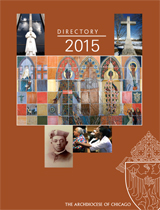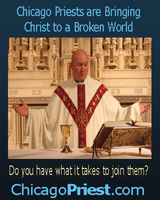June 21, 2009
Come, let us adore him Parishes throughout the Archdiocese of Chicago offer time for adoration of Jesus in the Eucharist
Every Monday, after the 6:30 a.m. Mass at Queen of the Rosary Parish in Elk Grove Village, Father Edward Pelrine places a consecrated host in a golden monstrance on the main altar of the church.
For the next 12 hours, until a closing rosary and Benediction in the evening, a steady flow of parishioners, including dozens of children from the parish school, come into the contemporary-styled church to pray. They quietly worship the Blessed Sacrament, sometimes for an hour, sometimes for just a few minutes. They are there to adore Jesus who is sacramentally present on their altar as part of the parish’s growing commitment to eucharistic adoration.
A year ago, when Pelrine arrived, parishioners asked if they could increase their adoration days from once a month to every week. Pelrine was glad to oblige. He sees what is happening at his parish as part of a growing trend throughout the archdiocese and the whole Catholic Church. “I think the explosion of eucharistic adoration is a completely unforeseen fruit of the Second Vatican Council,” Pelrine said. “Everybody thought it was dead, a thing of the past, but the laity are encouraging it and the Holy Spirit is drawing people to God through the Eucharist.”
There are now 234 parishes in the Archdiocese of Chicago offering a combined total of 250,384 hours of eucharistic adoration, according to a 2008 survey conducted by the Pope John Paul II Eucharistic Adoration Association. The association exists to promote eucharistic adoration throughout the archdiocese and lists sites for adoration on its Web site www.pjp2ea.org.
The Real Presence
Eucharistic adoration happens when, separate from the celebration of a Mass, a consecrated host is brought forth from a tabernacle and then exposed on an altar in a decorative metal holder called a monstrance. People gaze upon the Blessed Sacrament and worship it for what it truly is in the Catholic faith – the body, blood, soul and divinity of Jesus Christ – the Real Presence.
No precise date is given in the church’s history for the first occurrence of eucharistic adoration. But it is has long been encouraged by the church as a beloved devotional practice, intrinsically related to the Mass. It is meant to prolong the worship given to the Lord at Mass and offer time for personal union with the Son of God through prayer in the presence of the divine sacrament.
An important date in the history of eucharistic adoration was the proclamation in 1264 of the universal feast day of Corpus Christi by Pope Urban IV. This feast offered an opportunity to celebrate the church’s teaching on the real presence of Jesus in the Eucharist and it officially encouraged processions where the Blessed Sacrament was carried in pilgrimage throughout city streets, as well as the foundation of adoration chapels for regular worship of the Blessed Sacrament.
Religious orders with a special dedication to eucharistic adoration, such as the Franciscan Sisters of Perpetual Adoration were later formed and these spread throughout the world promoting adoration among the Catholic laity. The FSPA inaugurated eucharistic adoration at their motherhouse in La Crosse, Wis., on Aug. 1, 1878. It’s been going strong and continuously for more than 120 years.
Many opportunities to adore
There are 15 similar types of perpetual adoration chapels where adoration takes place 24 hours a day seven days a week in the archdiocese. They include Marytown in Libertyville, the Sanctuary of the Divine Mercy at St. Stanislaus Kostka Parish on the North Side, and St. Daniel the Prophet on the South Side. The main chapel at Marytown has had perpetual adoration since June 7, 1928, making it the longest running site for eucharistic adoration in the archdiocese. People sign up and commit to an hour, even during the early mornings between 1 a.m.-6 a.m.
A newer location for perpetual adoration is in Park Ridge. St. Paul of the Cross Parish celebrated four years of perpetual adoration at their parish chapel on the Feast of Corpus Christi this year.
Bob Maszka who helped start the St. Paul chapel said the chapel has received so many visitors, on average, nearly 800 visitors each week, that they had to recently replace the worn out carpet with a sturdier wooden floor. But it is the spiritual benefits of adoration that have most impressed and influenced Maszka.
“The chapel is a place where you feel very comfortable in coming and resting with Our Lord just like you would with a friend,” Maszka said. Regular prayer in the chapel has inspired him and others to help build a new church in Tanzania, he said. And he reported that he and many other leaders in the parish feel that all the parish’s ministries have flourished through the increase of prayer in the adoration chapel – from the school to the RCIA program.
Another place that has a successful parish-based perpetual adoration program is on the North Side of the city. Sally Suyosa has been praying a weekly holy hour since 1992 when the adoration chapel at her parish, Our Lady of Lourdes, opened.
“I pray and Jesus listens to me very well. I have received many graces that I need from going to the chapel,” said Suyosa, a Philippines native.
Still going
There was a time after the Second Vatican Council, with the emphasis on lay participation at the Mass and less emphasis on devotions, when many experts thought adoration would no longer be around by the 21st century. But that divide seems to be closing, according to Denis McNamara, a faculty member of the Liturgical Institute in Mundelein.
“We are in a time now where we should not see this distinction between devotion and liturgy in either/or terms.” McNamara said, “Rather, we have both liturgical participation and devotional life, and we understand how adoration flows from and back to the Mass.”
Recent popes have encouraged adoration and taught that there is an intimate connection between the Mass and eucharistic adoration. Pope John Paul II wrote, “Public and private devotion to the Holy Eucharist outside Mass is highly recommended: for the presence of Christ who is adored by the faithful in the Sacrament, derives from the sacrifice and is directed towards sacramental and spiritual communion.”
After a recent worldwide Synod of Bishops on the topic of the Eucharist, Pope Benedict affirmed that most definitively the eucharistic bread was given to us to be eaten, but also to be adored. He said, “Receiving the Eucharist means adoring him whom we receive. The act of adoration outside Mass prolongs and intensifies all that takes place during the liturgical celebration itself.”
More than one way
Besides perpetual adoration, there are a variety of formats for eucharistic adoration in the archdiocese: 22 parishes have some form of daily eucharistic adora- tion, 80 parishes have weekly programs such as at Queen of the Rosary, and 105 parishes have monthly programs such as a First Friday day of adoration. The John Paul II Eucharistic Adoration Society reports that there are at least 17 non-parish institutions, such as the Pauline Books and Media store on Michigan Avenue and the Women’s Center, a crisis pregnancy center on North Cicero Avenue, that maintain a regular schedule of adoration to which the public is welcome.
Loyola Academy in Wilmette began eucharistic adoration every student chapel and because of it’s success continued it throughout the rest of the school year. A Loyola Spanish teacher, Acacia Komelasky, started adoration at the school, having been a regular adorer with her husband for many years at Marytown.
“I believe I am doing what God has called me to do in starting adoration at the school. I have also received incredible peace, grace and encompassing love from Jesus and Our Lady through adoration,” said Komelasky, a Cuban native.
Auxiliary Bishop Joseph Perry is the moderator of the John Paul II Eucharistic Adoration society and an enthusiastic supporter and participant in eucharistic adoration. He reports that the pastors and parishes of the archdiocese have responded well to the group’s offer of assistance and the church’s guidance regarding eucharistic adoration.
“In this new millennium that has its own spiritual hungers, eucharistic adoration takes the mystery of the Lord’s Memorial from the Mass and spreads it throughout the day in Christian communities, offering a quiet locus for intimate prayer away from the noise and mayhem of life,” Perry said.
It was a similar love of eucharistic adoration that prompted Father David Simonetti to open a new place for prayer: the Pope John Paul the Great Chapel of Eucharistic Adoration at St. James Church in Sauk Village. The chapel is open from 9 a.m. to 9 p.m. daily. Simonetti, who is Cardinal George’s delegate for promoting eucharistic adoration in the archdiocese, said he hopes the chapel will eventually offer perpetual adoration.
Ceil Brieske, is the president of the John Paul II association is not surprised by Simonetti's passion. “Adoration is definitely growing throughout the archdiocese. I truly feel that the priests ordained in the last 10 years have had a strong effect on this,” she said. “Many of the young priests are adorers and speak from the pulpit about it and practice."
Brieske’s own life is woven with eucharistic adoration. She said that when she needs a place to get away from the noise and stress she heads to an adoration chapel.
“There we are united with the angels and saints in heaven at that moment, bathing in the Lord’s graces, the one certainty that never changes, his presence in the Blessed Sacrament.”
If things continue regarding adoration as they have at Our Lady of the Rosary, Pelrine predicts that he will be having more days of eucharistic adoration on offer at his parish and possibly some future vocations to the priesthood.
“One boy came up to me after his first time at adoration and Benediction and said, ‘That was the coolest thing I have ever seen in my life.’”
Pelrine said he told the boy he couldn’t agree more and he is now talking to him and all the eighth grade boys at his school about becoming priests some day and keeping eucharistic adoration going at their parish and throughout the whole Catholic Church.
For more information or to locate a chapel near you, contact the John Paul II Eucharistic Adoration Association of the Archdiocese of Chicago at www.pjp2ea.org or contact you parish secretary.
 Catholic
New World - Newspaper for the Archdiocese of Chicago
Catholic
New World - Newspaper for the Archdiocese of Chicago Archdiocese of Chicago Directory
Archdiocese of Chicago Directory Oficjalne wydawnictwo Archidiecezji Chicago w języku polskim
Oficjalne wydawnictwo Archidiecezji Chicago w języku polskim